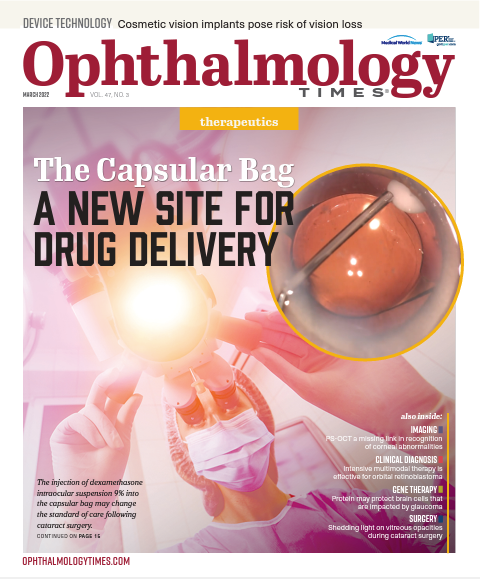Publication
Article
Digital Edition
Travoprost intracameral implant shows efficacy in topical form
Author(s):
Device demonstrates potential as a durable, sustained-release glaucoma therapy
Reviewed by Damien F. Goldberg, MD
One travoprost intracameral implant (OTX-TIC, Ocular Therapeutix) was as effective as the topical form of the drug in lowering IOP. The duration of the implant’s effect varied with the dose, according to Damien F. Goldberg, MD, who is in private practice in Torrance, California.

This result is important because the implant eliminates the poor patient adherence historically associated with topical instillation of antiglaucoma drugs. It also eliminates wastage of the drug and toxicity to the ocular surface resulting from topical instillation.
The travoprost intracameral implant had been tested in a preclinical study in Beagles, in which the device lowered IOP by 25% to 30% over the course of 4 to 6 months without any substantial changes in the central corneal thickness.
Goldberg and his colleagues conducted a phase 1 evaluation of the safety, efficacy, and biologic activity of the hydrogel-based, biodegradable, sustained-release device that was administered using a 26- or 27-gauge needle into the iridocorneal angle. The travoprost intracameral implant is loaded into microparticles in the hydrogel, Goldberg explained.
All patients had primary open-angle glaucoma or ocular hypertension. The device was implanted in 1 eye of each patient and the fellow control eye received topical travoprost. The IOPs were measured at 8 and 10 am and 4 pm at baseline; on days 14, 42, and 85; and at months 4 and 6.
Following a washout period, the patients were divided into 4 cohorts in which the study eye received different OTX-TIC doses. In cohort 1, 5 patients received 15 µg; in cohort 2, 4 patients received 26 µg; in 3, 5 patients received 15 µg of a rapidly degrading hydrogel; and in 4, 5 patients received 5 µg of a rapidly degrading hydrogel.
The investigators recorded the IOP measurements, adverse effects, endothelial cell count, and pachymetry.
Effects of OTX-TIC
“The patients in the 4 cohorts had adequate IOP reductions of [approximately] 7 to 11 mm Hg that was observed 2 days after the device was implanted, and the reductions were comparable to those achieved with topical travoprost,” Goldberg reported.
In cohorts 1 and 2, the IOP reductions lasted up to 7 months following implantation and in cohorts 3 and 4, 3 to 5 months.
When the data were broken out by individual cohort, cohort 2, in which patients received 26 µg of the drug, had the most consistent durable response that lasted out to 6 months; in 50% of the 4 patients the results lasted for 9 months. The results in cohort 1 showed that 60% of patients had a drug effect lasting to 6 months; in cohort 3, the IOP was controlled in 60% of patients to day 85; and in cohort 4, the IOP was controlled in 80% to month 6.
The investigators also found that the position of the implant in the angle remained stable until it biodegraded at 5 to 7 months in cohorts 1 and 2, and until 3 to 5 months in cohorts 3 and 4. In addition, no serious adverse effects occurred.
The corneal health also remained unchanged compared with baseline in all cohorts, with no meaningful changes in the pachymetry and endothelial cell counts.
“One OTX-TIC implant demonstrated potential as a durable, sustained-release glaucoma therapy. [It] produced IOP-lowering effects comparable to those achieved with topical travoprost as early as 2 days after implantation that lasted 6 months in cohorts 1 and 2 and out to 3 to 6 months in cohorts 3 and 4,” Goldberg said. “The position of the implants remained stable in the anterior chamber during the biodegradation processes of 5 to 7 months and 3 to 5 months, respectively. The device was safe and well tolerated.”
A phase 2 study is underway.
Damien F. Goldberg, MD
E: goldbed@hotmail.com
This article is adapted from Goldberg’s presentation at the 2021 American Academy of Ophthalmology annual meeting in New Orleans, Louisiana. Goldberg is a consultant to Ocular Therapeutix, which sponsored the trial.

Newsletter
Don’t miss out—get Ophthalmology Times updates on the latest clinical advancements and expert interviews, straight to your inbox.




